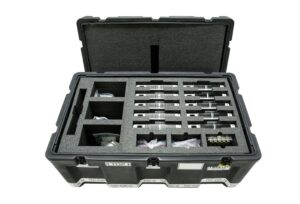
Remember to avoid these errors when designing custom cases with PSI!
Designing a custom case requires careful consideration to ensure your equipment is well-protected and easily accessible. At Packaging Strategies Inc., we have seen the best and worst of custom case designs and know what works and what doesn’t. Here are some common mistakes to avoid when designing your custom case, ensuring you get the best protection and functionality for your needs.
Choosing Stock Cases Over Custom
One of the biggest mistakes you can make is opting for stock cases instead of custom ones. Stock cases are designed to fit a broad range of items, but they often fall short when it comes to the specific needs of your equipment. Custom cases are tailored to your gear’s exact dimensions and requirements, offering superior protection and a perfect fit. By choosing custom designs over stock cases, you can ensure that your equipment is securely held in place, reducing the risk of damage during transit and storage.
Failing to Factor in Worst-Case Scenarios When Traveling
When designing a custom case, it’s crucial to consider the worst-case scenarios that your equipment might encounter during travel. This includes extreme temperatures, rough handling, moisture exposure, and accidental drops. Failing to factor in these scenarios can lead to inadequate protection and potential damage to your equipment. When designing a custom case, make sure it is built to withstand extreme conditions and includes features such as waterproof seals, thermal insulation, and shock-absorbing materials.
Using the Wrong Materials
The materials you choose when designing your custom case significantly impact its effectiveness. Using the wrong materials can compromise the protection and durability of the case. For instance, using low-grade plastics might save on cost, but they won’t provide the same level of impact resistance as high-quality polyethylene or polypropylene. Similarly, choosing inadequate foam for the interior can fail to provide the necessary cushioning. Always opt for materials known for their strength, durability, and suitability for your specific application.
Ignoring Future Needs
Designing a custom case without considering future needs can be a costly oversight. Your equipment requirements might change over time, and a case that cannot adapt to these changes will quickly become obsolete. Consider designing a case with modular components or adjustable compartments to accommodate new equipment as your needs evolve. This forward-thinking approach can save you time and money in the long run.
Neglecting Weight Distribution
Proper weight distribution is required for the safe and easy transport of your custom case. Ignoring this aspect can lead to a case that is difficult to handle and prone to tipping or damage. Ensure that the design of your custom case allows for even weight distribution, making it easier to carry and reducing the risk of accidents.
At Packaging Strategies Inc., we are dedicated to helping you design the perfect custom case for your needs. Contact us today for more information on our custom case solutions. Let us help you protect your valuable equipment with the best custom case design.
DEPEND ON PACKAGING STRATEGIES FOR YOUR CUSTOM PACKAGING NEEDS
Packaging Strategies has assembled a team with over 100 years of experience in design, engineering, development, manufacturing, and sales. We created the Packaging Strategies Design and Technology Center to create and manufacture complete systems integration packages and container solutions of all sizes and materials for our clientele. Many of these clients are federal agencies or in the private sector. No matter what you need to carry, Packaging Strategies is sure to have the right case for the job. You can view our website here, and follow us on Facebook, Twitter, Flickr, and LinkedIn.
